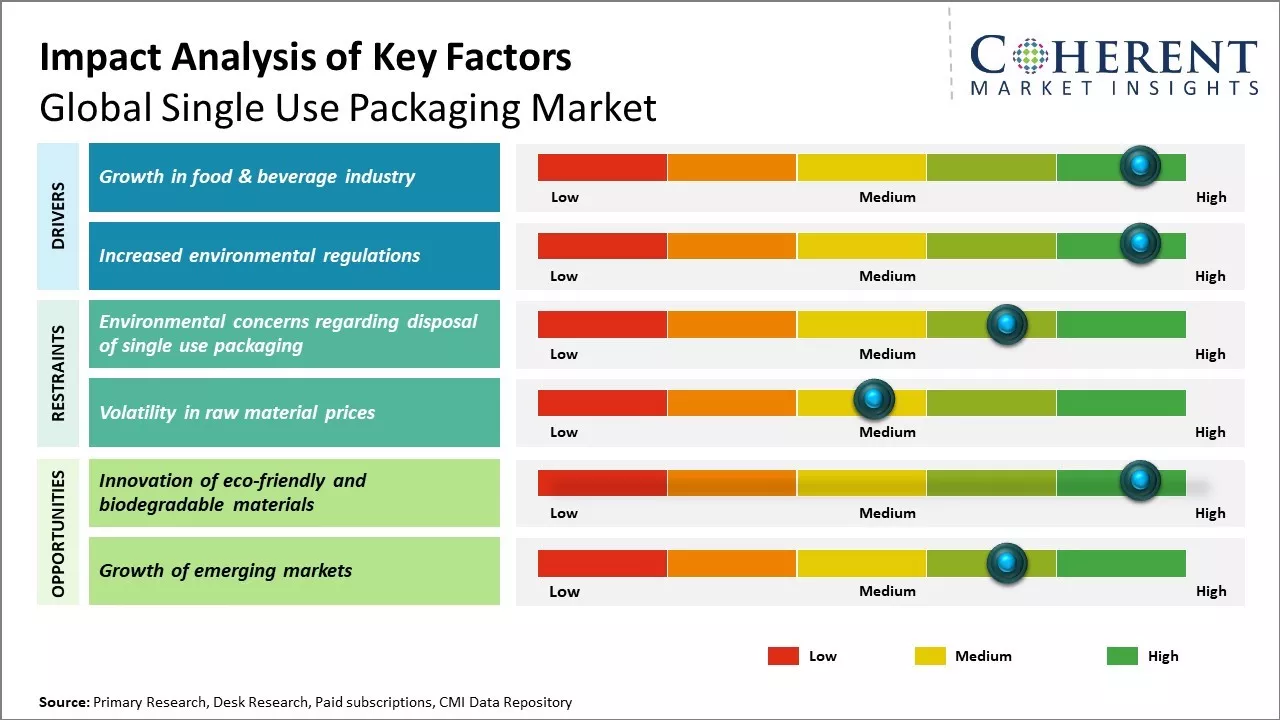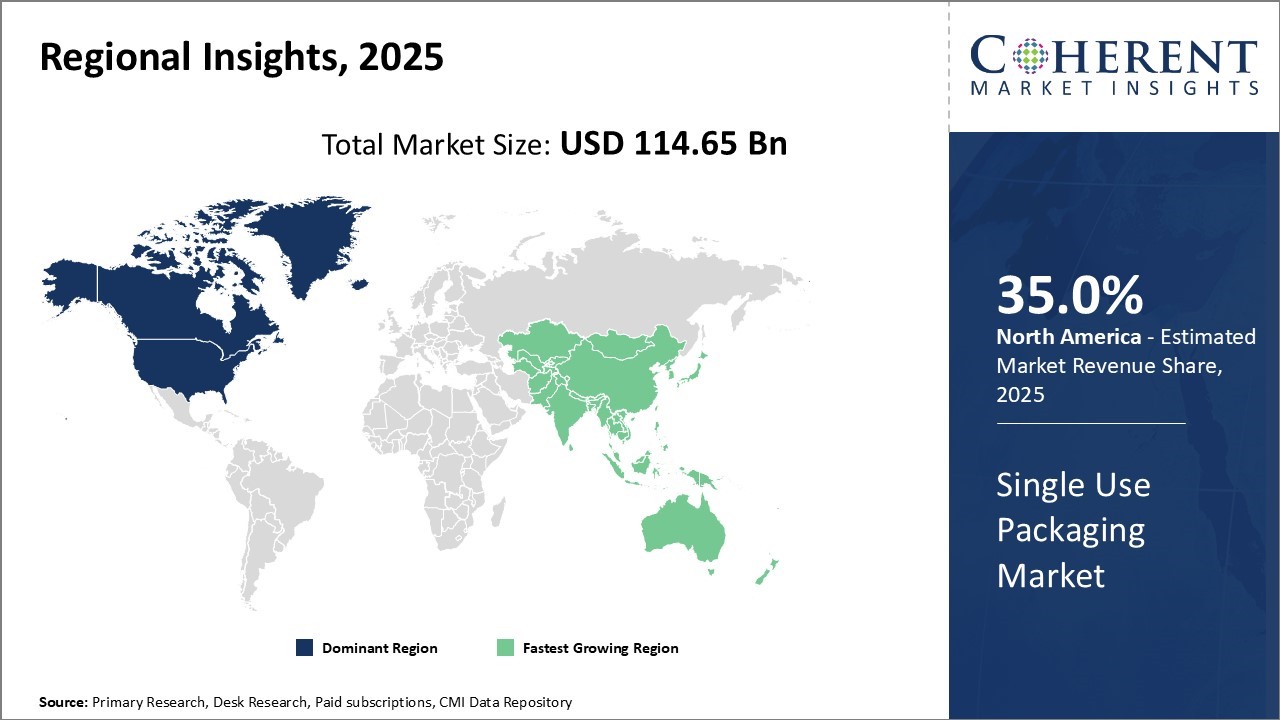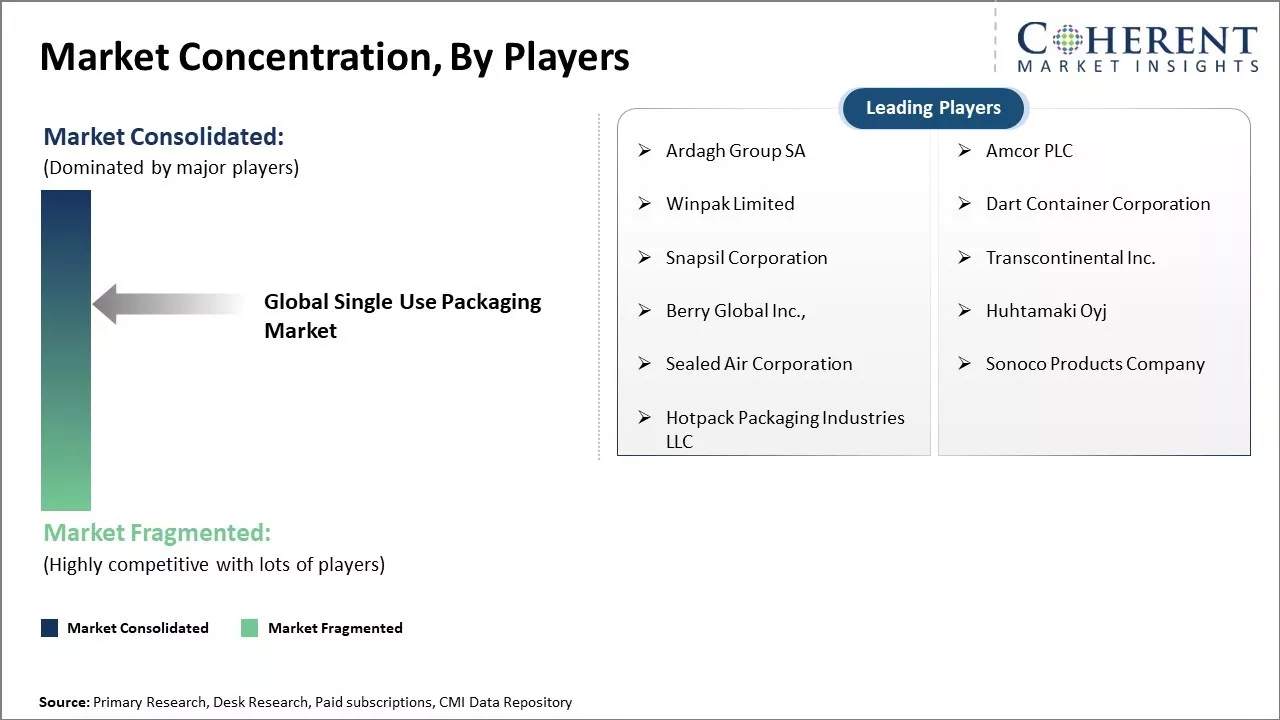Single Use Packaging Market is estimated to be valued at USD 114.65 Bn in 2025 and is expected to reach USD 170.23 Bn in 2032, exhibiting a compound annual growth rate (CAGR) of 5.8% from 2025 to 2032.

To learn more about this report, Download Free Sample
The Single Use Packaging Market Size is developing rapidly due to the growing need for single-serve, hygienic, and convenient products in sectors like food and beverage, healthcare, and personal care. The single use packaging market is expected to witness positive growth over the forecast period. The increasing demand from foodservice outlets and on-the-go food and beverage consumption are driving the growth of the market. Strong economic growth and changing lifestyles in developing countries are increasing the demand for convenience packaging solutions. Growth in the e-commerce industry is also favoring the market as more packages are needed for product delivery.
|
Event |
Description and Impact |
|
Rise of Sustainable Packaging Materials |
|
|
Growth of E-commerce and On-the-Go Consumption |
|
Uncover macros and micros vetted on 75+ parameters: Get instant access to report
The paper and paper board segment is expected to hold 42.7% share of the single use packaging market in 2025, due to strong consumer preference for more eco-friendly options. Paper products are widely considered to have a lower environmental impact than plastic or glass alternatives. As sustainability becomes an increasingly important factor in purchasing decisions, demand has grown for packaging made from renewable, natural materials like paper.
A key strength of paper is its ability to be recycled multiple times with minimal loss of quality. Recycling programs for paper are also more widespread and efficient than those for plastic or other materials. Single use packaging with manufacturing process is increasingly being scrutinized for its environmental impact, making paper a preferred choice for brands seeking sustainable alternatives.
This supports the perception of paper as a "green" packaging solution that can be reused or recycled responsibly at the end of its useful life. Companies promoting paper products emphasize their commitment to sustainability goals through the use of recycled content and fibers from responsible forestry sources.
Beyond environmental benefits, paper also performs well from a functional perspective for certain applications. Properties like printability, writability, and barrier qualities make paper well-suited for areas like food service disposables, paper bags, carton packaging, and protective wrapping or cushioning. Improvements in coating and lamination techniques further expand the versatility of paper-based solutions.
The food & beverage industry is expected to dominate the end-user segment with 32.8% of the market share in 2025, due to widespread reliance on single-use packaging for safe, hygienic and convenient product handling. Single-use packaging of condiments is a key example, ensuring portion control and minimizing contamination risks in both retail and foodservice settings.
Whether shipping raw ingredients and goods or ringing up prepared meals and drinks to go, disposable containers, bags, wrappers, and other packaging play a fundamental role throughout food/beverage supply chains.
From grocery stores to quick service restaurants, takeaway and delivery have become essential channels powered by single-use packaging. During the pandemic, demand skyrocketed as more consumers opted for contactless purchasing of prepared food ordered online or via mobile apps. Even as dining rooms reopen, off-premise consumption habits developed during lockdowns will likely remain significant drivers of food packaging consumption.
Within grocery, single-use formats are indispensable for everything from sliced meats and cheeses to bakery items, produce, snacks and frozen goods. Their tamper-evidence and protective properties preserve freshness throughout transport from manufacturers to retailers to homes. Similar needs apply in institutional foodservice serving cafeterias, hospitals, schools and airlines.

To learn more about this report, Download Free Sample
North America has established itself as the dominant region in the global single use packaging market. The region is expected to account for 35.0% of the market share in 2025. With the strong presence of major packaging producers as well as manufacturers across industries that consume significant amounts of single use packaging, the market has achieved notable scale.
Being an early adopter of single use packaging solutions to meet various needs has given North American players considerable experience and expertise. Meanwhile, growing environmental concerns have spurred innovation towards more sustainable product offerings in the region. This positions North America favorably to lead the transition towards greener single use solutions.
Among all regions, Asia Pacific has emerged as the fastest growing market for single use packaging. Rapid economic development and industrialization have fueled demand from diverse end-use sectors for conveniently packaged goods. At the same time, vast populations and urbanization and Westernization of lifestyles have increased consumption of ready-to-eat and on-the-go food products.
This has led Asian manufacturers to heavily rely on single use packaging materials to meet these needs efficiently. Countries like China, India, and other developing Asian nations also serve as key export hubs, giving an added boost to packaging requirements. As disposable incomes rise across the region, greater affordability also supports market expansion. While environmental issues pose future challenges, Asia Pacific's continued growth presents sizable opportunities for players to tap into the region's growing packaging needs.
The expanding food and beverage sector, the growing need for easy-to-use packaging options, and the ongoing regional growth of e-commerce are the main drivers of this growth.
Although plastic continues to be a prominent market due to its affordability and adaptability, materials like paper and paperboard are becoming more well-known due to their sustainability credentials and growing consumer preference for eco-friendly solutions, meal and beverage, personal care, and medicines are important end-user industries. The demand for effective single-use packaging is being driven by quick service restaurants and online meal delivery services.
Growth in the U.S. is driven by consumer demand for convenience, the rapid expansion of e-commerce, and the popularity of ready-to-consume food and beverages. The market is also seeing a shift toward sustainability, with companies increasingly adopting biodegradable and recyclable materials to meet both regulatory requirements and evolving consumer preferences.
India’s single-use packaging market is expanding rapidly, fueled by strong economic growth, urbanization, and a burgeoning food and beverage industry. The increasing penetration of organized retail, rising disposable incomes, and the growth of e-commerce platforms have significantly boosted demand for convenient and hygienic packaging solutions.
The single-use packaging industry is expected to play a significant role in the growth of the worldwide market, with China leading the Asia-Pacific region in both size and growth. The country's enormous population, rising urbanization, and the dominance of food delivery services and e-commerce are all factors contributing to the market's explosive expansion. From food containers to medical packaging, China's extensive production and manufacturing skills provide a broad range of single-use packaging options.
| Report Coverage | Details | ||
|---|---|---|---|
| Base Year: | 2024 | Market Size in 2025: | USD 114.65 Bn |
| Historical Data for: | 2020 To 2024 | Forecast Period: | 2025 To 2032 |
| Forecast Period 2025 to 2032 CAGR: | 5.8% | 2032 Value Projection: | USD 170.23 Bn |
| Geographies covered: |
|
||
| Segments covered: |
|
||
| Companies covered: |
Ardagh Group SA, Amcor PLC, Winpak Limited, Dart Container Corporation, Snapsil Corporation, Transcontinental Inc., Berry Global Inc., , Huhtamaki Oyj, Sealed Air Corporation, Sonoco Products Company, and Hotpack Packaging Industries LLC |
||
| Growth Drivers: |
|
||
| Restraints & Challenges: |
|
||
Uncover macros and micros vetted on 75+ parameters: Get instant access to report

To learn more about this report, Download Free Sample
The growth and expansion of the food & beverage industry continues to be a major driver for the increased adoption of single use packaging solutions globally. As consumer lifestyles and preferences evolve, there is a constant demand for new, convenient and on-the-go packaging formats that allow consumers to enjoy their snacks, meals or beverages wherever and whenever they want.
In response, companies in the food and beverage space are innovating and launching an array of ready-to-eat and ready-to-drink products that are packaged in single-serve containers which can be easily transported and disposed of after single use.
A prime example is how the quick service restaurant industry has expanded rapidly during recent years. Food chains are introducing new snacking and smaller meal options that are packaged in disposable containers suitable for eating outside the restaurant premises such as in offices, parks, or during travel.
Additionally, the thriving food delivery business has increased the need for stackable and leak-proof single-use packaging for transporting hot and cold food items safely to customers' doorsteps. On the beverage front, the rise of energy drinks, bottled coffees, juices, and flavored water segments have all contributed to higher consumption of single-portion plastic, glass or carton bottles instead of traditional multi-serve containers.
Heightened regulatory scrutiny on environmental pollution from plastic waste globally has emerged as a strong driver for the single use packaging market, particularly biodegradable and recyclable packaging materials. Various governments are implementing stricter rules around the usage of conventional plastic bags, straws, cutlery, and other disposable items due to the growing solid waste problem.
Environmental concerns around disposal of single-use packaging have emerged as a major restrainer for the growth of the single use packaging market. There is a rising awareness among consumers and regulators about the harmful impact of non-biodegradable and plastic packaging on the environment.
Large quantities of such packaging ends up in landfills or oceans every year, where it takes centuries to degrade and breaks down into microplastics that enters the food chain. This has led to governments across many countries introducing strict regulations around usage of certain kinds of plastics and mandates for minimum recycled content in packaging.
The market is also changing as a result of sustainability and regulatory demands. Due to strict laws such as the UK's Extended Producer Responsibility (EPR) standards and the EU's Packaging and Packaging Waste Regulation (PPWR), there is a noticeable shift toward the usage of recyclable, biodegradable, and paper-based packaging materials. Manufacturers are being pushed by these regulations to develop packaging made of fiber-based materials and monomaterials, which are less harmful to the environment and easier to recycle.
The single use packaging market currently faces significant opportunities with the rising demand for eco-friendly and biodegradable materials. As consumers become more environmentally conscious, they are increasingly looking for sustainable alternatives to traditional plastic packaging. Brands and retailers recognize the need to shift toward more sustainable options in order to appeal to these consumers and meet their expectations. Innovation in plant-based bioplastics made from agricultural byproducts offers a promising solution.
Materials like bio-PET (made from sugarcane), PHA (made by bacteria from plant oils), and cellulose (from wood or non-food plants) allow producers to create packaging that is largely biodegradable and compostable within just a few months. Some big brands have already started utilizing these materials for certain product lines, improving their green credentials amongst customers. For example, Nestle Waters North America has replaced the plastic rings on its water bottles with plant-based materials for certain brands which now decompose more quickly should they end up as litter.
Share
Share
About Author
Kalpesh Gharte is a senior consultant with approximately 5 years of experience in the consulting industry. Kalpesh holds an MBA in Operations and Marketing Management, providing him with a strong foundation in market strategy and analysis. He has contributed to various consulting and syndicated reports, delivering valuable insights that support informed business decisions
Missing comfort of reading report in your local language? Find your preferred language :
Transform your Strategy with Exclusive Trending Reports :
Frequently Asked Questions
Joining thousands of companies around the world committed to making the Excellent Business Solutions.
View All Our Clients